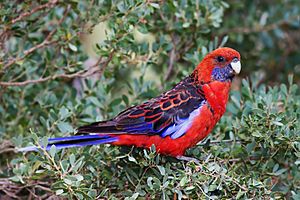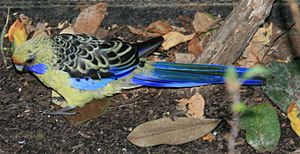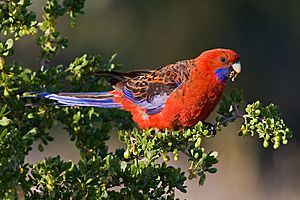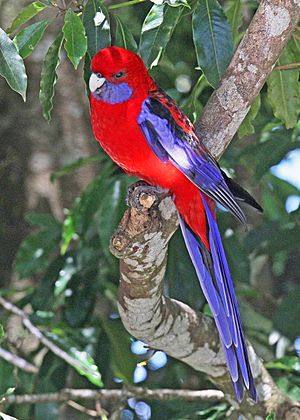Crimson rosella facts for kids
Quick facts for kids Crimson rosella |
|
|---|---|
 |
|
| Adult in Wilsons Promontory, Victoria | |
| Conservation status | |
| Scientific classification | |
| Genus: |
Platycercus
|
| Species: |
elegans
|
 |
|
| Crimson rosella range (in red; all-year resident) | |
| Synonyms | |
|
Psittacus elegans,Gmelin |
|
The crimson rosella (Platycercus elegans) is a beautiful parrot found in eastern and southeastern Australia. It has also been brought to New Zealand and Norfolk Island. You can often spot these colorful birds in mountain forests and gardens. What we call the crimson rosella today actually includes two types that used to be seen as separate species: the yellow rosella and the Adelaide rosella.
Contents
About the Crimson Rosella's Name
The crimson rosella got its first scientific name, Psittacus elegans, in 1788 from a scientist named Johann Friedrich Gmelin. Another scientist, John Latham, also described this bird in the late 1700s. He called it the "Beautiful Lory" and later the "Pennantian Parrot."
In 1825, Nicholas Aylward Vigors created a new group for these birds called Platycercus. This name was chosen because of the special way their tail and wing feathers are shaped.
For a long time, people used Latham's name for the bird. But in 1891, it was decided that Gmelin's name, P. elegans, was the correct one to use.
In 1941, another scientist, Herbert Condon, suggested that the yellow and Adelaide rosellas should be considered types (subspecies) of the crimson rosella. This idea is now widely accepted.
Today, the official name for this bird is "crimson rosella." Before 1926, it was often called the "crimson parrot." On Norfolk Island, people simply call it the "red parrot."
The yellow rosella is another type of this bird. It lives along the Murray River. Scientists now consider it a subspecies called P. elegans flaveolus. This is because the yellow and crimson rosellas can breed together where their homes overlap.
What Does a Crimson Rosella Look Like?
The Platycercus elegans is a medium-sized Australian parrot. It is about 36 centimeters (14 inches) long, and a lot of that length is its tail!
There are seven different types, or subspecies, of this bird. Three of these are truly crimson (red). But in one type, the red color is replaced by yellow. Another type, the Adelaide rosella, has a mix of red, orange, and yellow.
Young crimson rosellas often look quite different from adults. In southeastern Australia, young birds are mostly greenish-olive. This green color is strongest on their neck and chest. As they get older, they slowly change from green to red.
All types of crimson rosellas have blue cheeks. Their wings have black scales with blue edges. Their tails are mostly blue. The blue tail feathers are so pretty that satin bowerbirds sometimes use them to decorate their nests! The rosella's beak is light gray, and its eyes are dark brown.
It's hard to tell male and female crimson rosellas apart just by looking. The main difference is that males are usually up to 15% bigger. They also have a slightly larger and wider beak.
Different Types of Crimson Rosellas
The main type, P. elegans elegans, lives in Victoria and eastern New South Wales.
P. elegans nigrescens lives on Queensland's northeastern coast. P. elegans melanoptera lives on Kangaroo Island. The biggest differences between these types are their size and color. Nigrescens is the smallest and melanoptera is the largest. Both are a bit darker than the main type.
Interestingly, young P. e. nigrescens birds do not have the greenish feathers that young birds of other types do.
Yellow Rosella
The yellow rosella lives along the Murray River. In 1968, it was reclassified as a subspecies, P. elegans flaveolus. This happened because scientists found that yellow and crimson rosellas breed together where their homes meet. The main difference is that the yellow rosella has light yellow where the crimson rosella has red. Its tail is also more greenish.
Adelaide Rosella
The Adelaide rosella lives near Adelaide. People used to think it was a separate species. But now, scientists believe it's a mix of crimson and yellow rosellas. This mix happened because the two types bred together.
Where the Adelaide rosella's home meets the crimson or yellow rosella's home, they still breed together. This means the Adelaide rosella's feathers can look different. They can be dark orange-red in the south and a pale orange-yellow in the north.
Where Do Crimson Rosellas Live?
Crimson rosellas live in southeastern South Australia, Tasmania, Victoria, and along the coast of New South Wales into southeastern Queensland. There is also a separate group in North Queensland.
Around 1910, some crimson rosellas were set free in New Zealand. They bred with another type of rosella, and by the 1950s, there were no pure crimson rosellas left there. This mixed group still lives there today.
Crimson rosellas were also brought to Norfolk Island a long time ago as pet birds. They escaped and became very common by 1900. On Norfolk Island, they are often called "red parrots." This helps tell them apart from the native Norfolk Island parakeet, which is called the "green parrot."
These rosellas are common in forests, especially older, wetter ones. You can find them from sea level all the way up to the tree line in mountains. They also live in places where humans are, like farms, parks, gardens, and golf courses. They usually avoid areas with no trees. At night, they sleep high up in tree branches.
How Do Crimson Rosellas Behave?
Most rosellas stay in one area. They don't migrate (travel long distances). When it's not breeding season, crimson rosellas often gather in pairs or small groups to find food. The biggest groups are usually young birds, with up to 20 individuals. When they look for food, they are easy to spot and make a lot of noise.
Rosellas stay with one mate for life. During the breeding season, adult birds don't gather in big groups. They only look for food with their mate.
A recent study showed that crimson rosellas can tell birds of their own type apart just by their smell!
What Do They Eat?
Crimson rosellas find food in trees, bushes, and on the ground. They eat fruits, seeds, nectar, berries, and nuts from many different plants.
Even though they eat fruits and seeds, rosellas don't help spread seeds. This is because they crush and destroy the seeds when they eat them. Sometimes, their diet causes problems for farmers. The birds can damage fruit and grain crops. In the past, this led to many rosellas being shot. Adelaide rosellas are known to eat cherry flower buds.
Rosellas also eat many insects and their young. This includes termites, aphids, beetles, and caterpillars.
How Do They Breed?
Crimson rosellas build their nests in hollows inside tree trunks, branches, or stumps. These hollows can be over 1 meter (3 feet) deep and up to 30 meters (98 feet) above the ground. The female chooses the nesting spot.
Once chosen, the pair gets the nest ready. They line it with wood bits they chew off the inside of the hollow. They don't bring in materials from outside. Only one pair will nest in a particular tree. They guard their nest by sitting nearby and chattering at other rosellas that come too close. They also protect an area around their nest, keeping other pairs from nesting there.
The breeding season for crimson rosellas is from September to February. It can change depending on how much rain there is each year. It starts earlier and lasts longer in wet years.
Females lay 3 to 8 eggs. They lay them one at a time, about every two days. The eggs are white and slightly shiny. They are about 28 by 23 millimeters (1.1 by 0.9 inches) in size. Only the mother bird sits on the eggs to keep them warm. This takes about 20 days.
The eggs usually hatch around mid-December. On average, about 3 or 4 eggs hatch successfully. More female chicks hatch than male chicks. For the first six days, only the mother feeds the baby birds. After that, both parents feed them.
The young birds become independent in February. They stay with their parents for a few more weeks before joining a group of other young birds. Young rosellas get their adult feathers when they are about 16 months old.
Color Changes
The most common crimson rosella is red. But there are also some natural color changes, called mutations. These include blue, yellow, white, and cinnamon colored rosellas. These are often seen in birds kept as pets.
What Threats Do They Face?
Crimson rosellas have predators like the peregrine falcon, grey goshawk, and powerful owl. Wild cats and foxes also hunt them. Possums and currawongs might sometimes take eggs from their nests.
Surprisingly, crimson rosellas can also be a threat to each other. During breeding season, female rosellas sometimes fly to other nests and destroy the eggs. This is the most common reason why an egg might not hatch. Scientists think this happens because there aren't enough good nesting spots. If all the eggs in a nest are destroyed, the nest will be left empty. Rosellas often try to nest in the same area each year.
A new study has shown something interesting about mixed-breed (hybrid) birds. Scientists found that hybrid rosellas were better at fighting off diseases than purebred ones. This is an example of something called "hybrid vigor." It means that a mixed-breed animal can be stronger than its two purebred parents.
Scientists studied how a feather disease affected crimson rosellas in Australia. They looked at mixed groups where two types of rosellas had bred together. They found that when these different types mated, their offspring seemed to handle a dangerous virus better.
Images for kids
See also
 In Spanish: Perico elegante para niños
In Spanish: Perico elegante para niños








